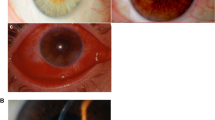Abstract
Introduction
The objective of this pilot study was to determine the preliminary efficacy of a novel ophthalmic suspension containing povidone-iodine 0.4% and dexamethasone 0.1% in the treatment of adenoviral conjunctivitis.
Methods
A prospective, open-label, single-armed, phase II clinical trial in humans. Eligible patients with the clinical signs and symptoms of acute conjunctivitis who tested positive for adenoviral antigen by Rapid Pathogen Screening (RPS) Adeno Detector™ were enrolled in a single treatment arm consisting of a combination povidone-iodine 0.4%/dexamethasone 0.1% sterile ophthalmic suspension given four times daily for a minimum of 5 days. RPS Adeno Detector testing was performed at baseline and at each follow-up visit along with ocular fluid sampling by conjunctival swabs. Subsequent analysis performed on all swabs included both adenoviral titer by quantitative polymerase chain reaction (qPCR) and cell culture with confirmatory immunofluorescence (CC-IFA). The primary endpoint was clinical resolution of conjunctival injection and discharge. Secondary measures included reduction of qPCR titers and eradication of infectious virus as determined by CC-IFA.
Results
A total of nine eyes of six patients with clinical signs and symptoms of acute viral conjunctivitis and a positive RPS Adeno Detector test result were enrolled in the study. In eight/nine eyes enrolled in the study, clinical resolution was observed by day 3 or day 4. In six/six eyes with detectable adenovirus by qPCR, significant reduction in viral titer was seen by day 3, day 4, or day 5. In five/six eyes with infectious virus confirmed by CC-IFA at enrollment, elimination of infectivity was achieved by day 4 or day 5. One patient was lost to follow-up.
Conclusions
An ophthalmic suspension containing povidone-iodine 0.4% and dexamethasone 0.1% may be a useful agent in the treatment of acute RPS Adeno Detector-positive conjunctivitis. A further placebo-controlled study with a larger number of patients is warranted.
Similar content being viewed by others
References
Ford E, Nelson KE, Warren D. Epidemiology of epidemic keratoconjunctivitis. Epidemiol Rev. 1987;9:244–261.
Hillenkamp J, Reinhard T, Ross R, et al. The effects of cidofovir 1% with and without cyclosporin A 1% as a topical treatment of acute adenoviral keratoconjunctivitis: a controlled clinical pilot study. Ophthalmology. 2002;109:845–850.
Teuchner B, Nagl M, Schidlbauer A, et al. Tolerability and efficacy of N-chlorotaurine in epidemic keratoconjunctivitis - a double-blind, randomized, phase-2 clinical trial. J Ocul Pharmacol Ther. 2005;21:157–164.
Romanowski EG, Gordon YJ. Efficacy of topical cidofovir on multiple adenoviral serotypes in the New Zealand rabbit ocular model. Invest Ophthalmol Vis Sci. 2000;41:460–463.
Clinicaltrials.gov web site. An evaluation of the efficacy and safety of AL-46383A ophthalmic solution for the treatment of adenoviral conjunctivitis. Identifier: NCT00901693. Available at: http://clinicaltrials.gov/ct2/results?term=NCT00901693. Accessed August 2009.
Romanowski EG, Roba LA, Wiley L, Araullo-Cruz T, Gordon YJ. The effects of corticosteroids on adenoviral replication. Arch Ophthalmol. 1996;114:581–585.
Bhagwat D, Oshlack B. Stabilized PVP-I solutions. United States Patent 5126127. June 30, 1992. Available at: www.freepatentsonline.com/5126127.html.
Berkelman R, Holland B, Anderson R. Increased bactericidal activity of dilute preparations of povidone-iodine solutions. J Clin Microbiol. 1982;15:635–639.
Hale E. The treatment of corneal ulcer with povidone-iodine (Betadine). N C Med J. 1969;30:54–56.
Isenberg SJ, Apt L, Valenton M, et al. A controlled trial of povidone-iodine to treat infectious conjunctivitis in children. Am J Ophthalmol. 2002;134:681–688.
Schuhman G, Vidic B. Clinical experience with povidone-iodine eyedrops in conjunctivitis and keratoconjunctivitis. J Hosp Infect. 1985;6(suppl. A):173–175.
Pernicky J. Our experience with the use of povidone-iodine drops in the treatment of viral conjunctivitis [article in Czech]. Czechoslovenska Oftalmologie. 1994;50:323–325.
Apt L, Isenberg SJ, Yoshimori R, Spierer A. Outpatient topical use of povidone-iodine in preparing the eye for surgery. Ophthalmology. 1989;96:289–292.
Speaker MG, Menikoff JA. Prophylaxis of endophthalmitis with topical povidone-iodine. Ophthalmology. 1991;98:1769–1775.
Isenberg SJ, Apt L, Yoshimori R, Pham CB, Lam NK. Efficacy of topical povidone-iodine during the first week after ophthalmic surgery. Am J Ophthalmol. 1997;124:31–35.
Isenberg SJ, Apt L, Wood M. A controlled trial of povidone-iodine as prophylaxis against ophthalmia neonatorum. N Engl J Med. 1995;332:562–566.
Abel R, Abel AD. Use of povidone-iodine in the treatment of presumptive adenoviral conjunctivitis. Ann Ophthalmol. 1998;30:341–343.
Weijtens O, Schoemaker R, Romijn F, et al. Intraocular penetration and systemic absorption after topical application of dexamethasone disodium phosphate. Ophthalmology. 2002;109:1187–1191.
Awan M, Agarwal P, Watson D, et al. Penetration of topical and subconjunctival corticosteroids in human aqueous humor and its therapeutic significance. Br J Ophthalmol. 2009;93:708–713.
Holland EJ, Bartlett JD, Paterno MR, et al. Effects on loteprednol/tobramycin versus dexamethasone/tobramycin on intraocular pressure in healthy volunteers. Cornea. 2008;27:50–55.
Mohan N, Gupta V, Tandon R, et al. Topical ciprofloxacin-dexamethasone combination therapy after cataract surgery randomized controlled clinical trial. J Cataract Refract Surg. 2001;27:1975–1978.
Samson CM, Capriotti JA, Liang B. Ophthalmic compositions comprising povidone-iodine. United States Patent Application 20070219170. September 20, 2007. Available at: www.freepatentsonline.com/y2007/0219170.html.
Krachmer J, Mannis M, Holland E. Cornea and External Disease: Clinical Diagnosis and Management. St. Louis: Mosby; 1997:773–775.
Smolin G, Thoft R. The Cornea: Scientific Foundations and Clinical Practice. Fourth Edition. New York: Lippincott Williams & Wilkins; 2004:359–364.
Author information
Authors and Affiliations
Corresponding author
Rights and permissions
About this article
Cite this article
Pelletier, J.S., Stewart, K., Trattler, W. et al. A combination povidone-iodine 0.4%/dexamethasone 0.1% ophthalmic suspension in the treatment of adenoviral conjunctivitis. Adv Therapy 26, 776–783 (2009). https://doi.org/10.1007/s12325-009-0062-1
Received:
Published:
Issue Date:
DOI: https://doi.org/10.1007/s12325-009-0062-1




